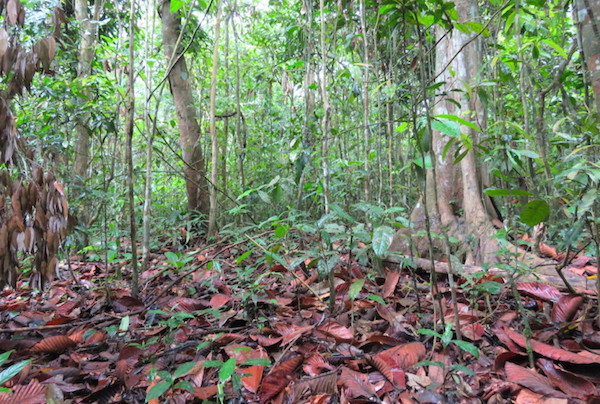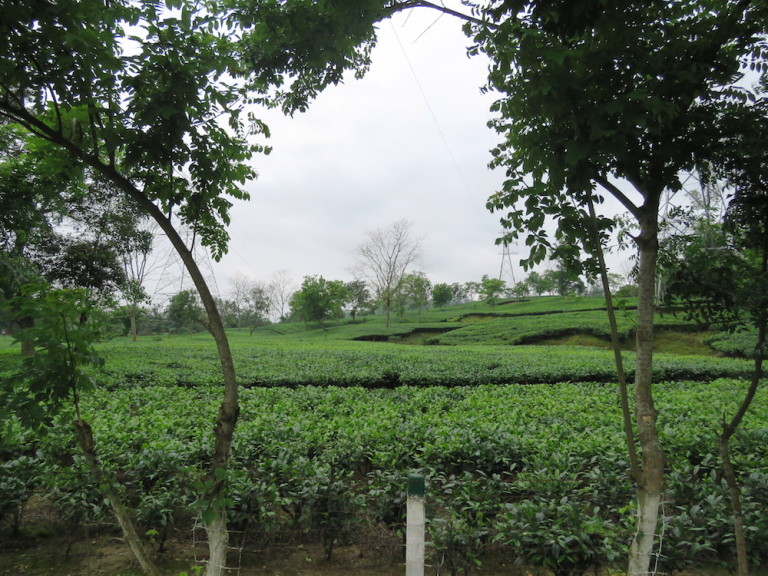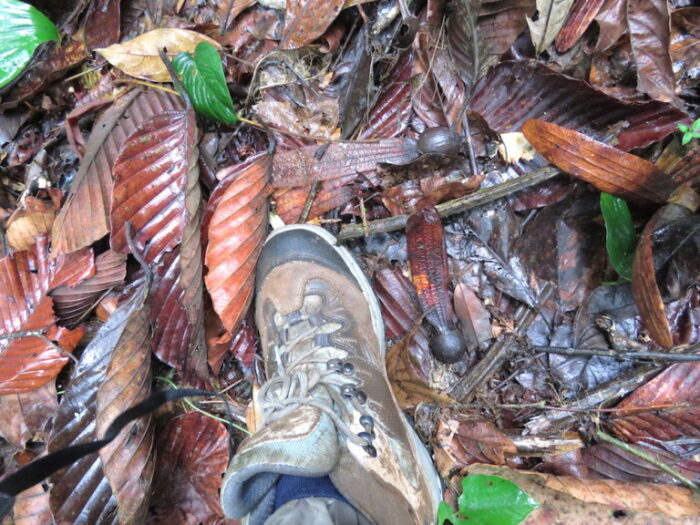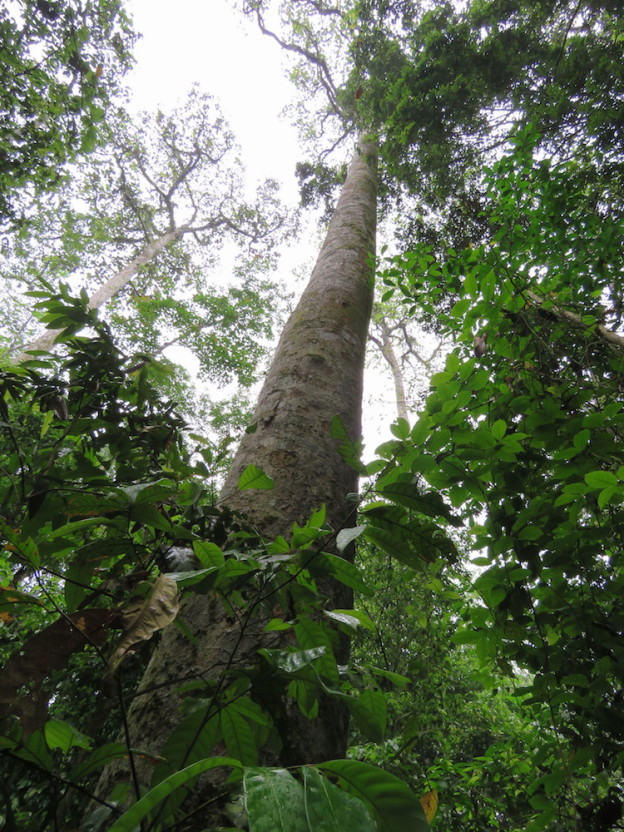
In the summer of 2015, I was in Northeast India, doing a field reconnaissance to find a field site for my Masters’ dissertation. Since I aspire to be a carnivore biologist, I thought to myself, what place better than Jeypore-Dehing forest? It has the distinction of having seven wild cat species- the highest recorded Felid diversity in the world! While travelling towards Jeypore town, I couldn’t help but wonder – was I being foolish? This was my first time in the Northeast, and I knew absolutely about nothing about Upper Assam. I had only spoken to the welcoming Deputy Forest Officer Mr. P. Terang, who assured me of a room in the forest rest house. I wondered if I would feel lost and lonely. But now wasn’t the time to wonder, it was the time to act. Now or never. So I set off on my own little adventure to Jeypore, and ever since then, I am so glad I did take the leap of faith.
Jeypore is a little town in Upper Assam, tucked far away from the mainland. The place is very small, and the only buildings you will see are those of the post office, a police station, forest department, a small school and an archaeological survey office. One can walk through all the roads and lanes of Jeypore in less than half an hour! Jeypore has a rich history, remnants of which you will see functioning even today. In the height of pre-colonial rule, this village was under Ahom rule. It was a strategic location for Ahom and Burmese rulers, and a centre of constant tussle for the two kingdoms. The British in the early 1800s saw the potential of its land for growing tea and that of its forests for extracting timber. Later on, the British set up tea plantations after clearing much of the forest, and logging operations started out from 1920s until the recent ban in 1996. Even today, sprawling tea estates and oil refineries that are decades old will greet you before you arrive at Jeypore. The road towards the town is only one and it eventually leads to Arunachal Pradesh. The shops here were huts of straw. A single straw hut had an ironing centre, a vegetable stall and a towel store. Goats and cattle roamed freely as always, and ducks squawked away. Vast expanses of rice and tea stretched on for hours, with workers walking into and out of them, wearing conical hats of straw. One of the workers, an old man in a pair of shorts and the hat, had a maniacal smile which was impossible to forget. The air in this place was laden with rain and the forest was a five minute walk away. I felt I was transported back into time in a sleepy village. I had already fallen in love with this place.

Jeypore Reserved Forest is contiguous with the Namdapha National Park (Arunachal Pradesh), a part of the northernmost tropical forests of the world. The forest is filled with Hollong and Bhelu- gigantic Dipterocarp trees which tower over 50 metres- I could not get one to fit into my camera frame! One needs to stand under these trees to get a real sense of how miniscule we really are. The left part of the lone road that leads into the forest is a part of the Dihing-Patkai Wildlife Sanctuary, whereas the rest of it falls under the Reserved Forest.
I walked through the forest with Dilip Gogoi, a calm and reserved forest guard who knew his way around really well. He was always armed with a dao, a knife that could cut through anything with ease. Over the next few days, he guided me through the forest, steered us clear of elephants and showed me a wonderful lifer- a Red Headed Trogon- a beautiful rare bird found only in the Northeast region of India. It has vibrant red plumage and is still quite hard to spot. The forest is filled with birds like Trogons, Sultan Tits, Hornbills and Babblers. Mammals like Malayan Bears, Martens, Marbled Cats, Tigers, Clouded Leopards, Capped Langurs, Elephants and Hoollock Gibbons live in this forest. One day, it started raining heavily. Dilip walked on without a raincoat, and in a show of solidarity I didn’t wear mine either. We walked through the slush. The raindrops felt cold and nice. Raindrops hung from the blades of palm leaves. I saw my own eyes stare back at me in wonder as I peered into them. Soon enough, we reached a very dense part of the forest. We smelled elephant urine and stepped onto freshly snapped bamboo. Time to leave, Dilip said. Dark clouds could be seen from tiny gaps in the canopy and they lent the entire forest a dark hue. We stepped on seeds of various shapes and sizes. The Hollong seed, with its round base and two long leaf like blades, was my favourite. The seeds travelled through the air in slow flight of round whirls before crashing gently onto the forest floor. Whilst watching that scene, time seemed to have slowed down. Set against the background of falling seeds was the flight of noisy parakeets, high in the sky.

As one walks deeper into the forest, there is a transition from gigantic tree trunks to lianas (woody climbers) to palms. Here, every place is a unique micro habitat within itself for all creatures big and small. Ants and spiders crawl over the trunks. Snakes crawl over the thick lianas and grasshoppers and birds flit to and fro on the branches. The streams we crossed led to marshes and ponds that were home to hundreds of croaking frogs. This forest is a matter of ecological pride also because of its cat community. A camera trapping study in the years of 2007 to 2009 has confirmed the presence of Tigers, Leopards, Clouded Leopards, Asiatic Golden Cats, Marbled Cats, Jungle Cats and Leopard Cats. As I walked on the trails, I wondered if the cats were watching us.
Just as the forests of Jeypore are beautiful, so are its people of among the kindest I have met so far. Pinky, the lady who sells biscuits and prepaid phone recharge, will ask you to pull up a chair to talk to her. I spoke to her for over an hour about all sorts of things. She told me of her Bengali heritage, how she loved being busy and her impending wedding. Although she was a stranger, I felt very comfortable with her and could tell her anything and everything. She was so interested in every small detail. I had not seen that look of genuine interest on anyone’s face in a while. Back home, there are so many things to talk to people about, but everyone is so busy with ‘work’ on their laptops and phones. Nobody has the ‘time’. Here was a lady who worked hard as well, but somehow her life seemed richer than ours. She made her own time to talk to strangers.
Biju, the bungalow caretaker, was deceptively quiet at first. Soon, we were discussing ‘Magic’ phone talk-time packs that saved money. He livened up at the sight of my khakhee leech socks, vehemently claiming that the design had originated in Jeypore, a claim I wouldn’t be surprised to find true.
I would eat my meals at the Borpujaris, a family that lived right in front of the forest rest house. The first time I visited them, a boy of five, peeked at me through the window curtain and ran inside to inform his mother. The elder sister smiled and soon the mother greeted me. She had no idea I was coming today. I felt slightly guilty, but the mother rushed in to cook what she called a simple meal. Chicken, vegetables, dal, rice, roti, salad, pickle and sweet. This was what she meant by simple. Oh, and the Bhatkarela (a vegetable grown in Assam) and fern dishes (yes, fern is a local delicacy) – I still reminisce about the aftertaste on my tongue sometimes. Assamese hospitality had been wonderful- they made me one of their own.
Everyone advices girls travelling solo to be careful, but with people like these, I didn’t have to worry at all. Mrs. Borpujari would make the tastiest tea every evening and we would chat by the balcony. I always looked forward to those chats. She told me about how she didn’t like leeches and rainforests, about how she regularly saw wildlife in Golaghat (where she hailed from) and about how she wanted a better life for her kids, probably in a town like Dibrugarh. We would talk loudly, straining to hear each other over the pitter-patter of rain and the din of macaques over the roof. The family had a small tea garden where Great Hornbills could be spotted almost any time of the day. A stray dog often dashed into the tea garden, barking away until some of them lazily moved around. Most of them paid no heed to the poor dog with his flappy ears.
One day I ditched the forest trails for a tour of the town side. I visited Tinsukia, Naharkatiya and Duliajan, watching tea estates, oil refineries along highways, and beautiful huts with pigs and ducks lazing near the home ponds as I would enter residential areas. In Tinsukia, I visited a temple where a tree is worshipped. The devotees come to ask for a wish- a mannat. When it is fulfilled, they tie bells around the temple. The entire temple premises and fences were filled with metal bells of all sizes! I noticed that almost every house in Assam has a pond, and the chances of this increase you move from the towns into villages. Every now and then, the roads would be lined by oil tankers, paan stalls and music stores constructed entirely of wood. The folks here seemed to be in no hurry. I drove past a group of men playing Ludo, one of them wearing a straw round-framed hat. They looked from another era, lost in the strategies of their game. Everybody was in their own world here.

Here I had not only enjoyed the wonders of a lovely dipterocarp forest, but had also learnt that kindness comes in all flavours, and that the people around us are full of goodness of spirit. We may be different in many ways from others, but in no way is that a barrier to connecting with them. Jeypore is truly a Paradise on Earth.
But that Paradise is in trouble. Tropical forests face multiple threats in this era, and this place is no exception. The forests of Jeypore have not received much scientific attention and its wildlife lacks adequate legal protection. Being a border area, this forest is manned by the army. The forest is said to have the presence of ULFA (United Liberation Front of Assam) an outfit which has been struggling since 1979 to form a socialist state. The presence of militant activity and the army have created a delicate political that has an underlying tone of social dissent. Tensions between the locals and the army often run high. Here, taking sides is dicey- for the army is doing it’s job and the locals want to be left alone. Add to that the existence of a thriving industry around the forests. Industries mean more capital, more roads, and more ‘development’. If wide-scale historical logging in these forests wasn’t enough, ‘development’ could mean ancillary problems in the form of wider roads and encroachments, leading to enhanced connectivity into the forest for logging and hunting activities.
In the recent past, events such as the ‘Rainforest Festival’ conducted here in 2015 have played a key role in uplifting people’s spirits. Although the issues of hunting and militancy may take longer to fade away, at least there is consolation in knowing that the locals and the Forest department are showing a keen interest in protecting their very own rainforest for the years to come.
How to get there:
Nearest airport & station: Dibrugarh town from where one can hire a cab or an auto to Jeypore (the road trip beautiful in itself, offering glimpses of the rural Assam life complete with rice fields, small lake and waterbirds).
For accommodation: The DFO needs to be contacted for accommodation in the Forest Inspection Bungalow. Alternately, one can talk to the locals of the town for a homestay arrangement. You can contact the DFO by writing to him at – dfodibrugarh@gmail.com
Thank you for the nice blog…
Hey, Anushka while browsing through after boredom work in office I co Incidently found your beautiful blog with pleasant writting, that remind me of my home from where M far now, Yaa exactly Jeypore my Birthplace and the Forest IB , (mychildhood playground with lots of sweet memories )is right infront of my house where you might hav stayed.First of all thank you for chossing our place and hats off for your courage and patience in the flied you have chosen for. The family you have mentioned in your blog BORPUJARI, they are our neighbour and the little boy is Paul and his Sister Pahi they have now grew up and most probably comes taller than their Mom , MRS Borpujari i.e Geeti Khuri (aunt) and Pinky is also our neighbour. For a few moment the picture of my village reflects an d help me to relax and boost up my mind ,Once again thank you for the beautiful blog and all the best for your projects. With regards Prasan Singh Lama